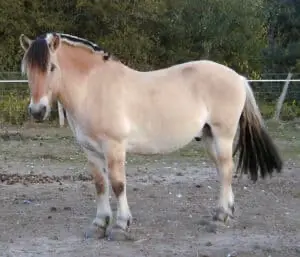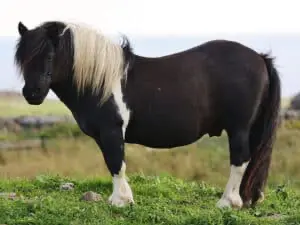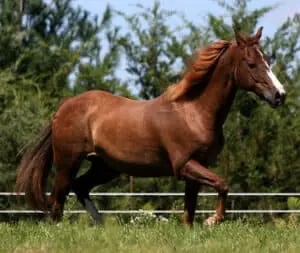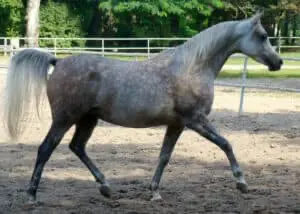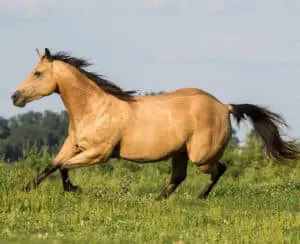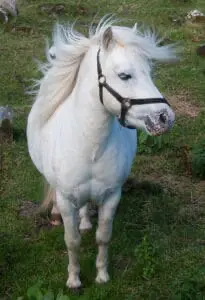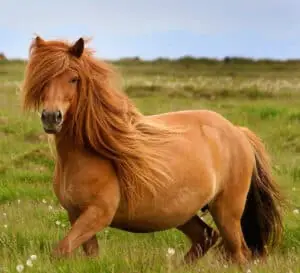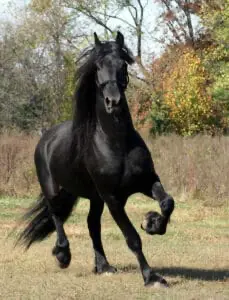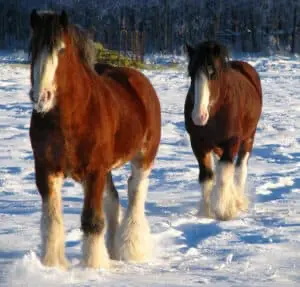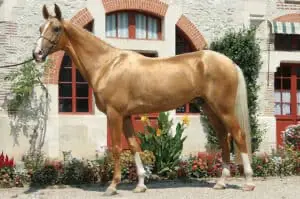It doesn’t matter if you’re looking for your hundredth horse or your first-ever horse, nobody wants a horse that is grumpy, miserable, and just generally unfriendly and while a horse’s personality obviously isn’t breed-specific and is as unique as our’s there are some breeds that are known for their friendly natures which is why I decided to write this.
In this article, we’ll cover the top 10 friendliest horses which are:
- Norwegian Fjord
- Shetland Pony
- Morgan
- Arabian
- Quarter Horse
- Connemara Pony
- Icelandic Horse
- Friesian
- Clydesdale
- Akhal Teke
What makes a horse friendly?
This is one of those ‘how long is a piece of string’ kind of questions that doesn’t really have an answer. The dictionary definition of friendly says ‘kind and pleasant, not in conflict’, and while that of course is true everybody will also have their own opinion of what characteristics a friendly horse should have. Some will say that the horse should show affection while others will say they should be quiet and gentle. Whatever your definition of friendly is, I’m sure you’ll agree that the breeds below will all live up to that.
Norwegian Fjord
Height: Most horses will stand between 14hh (56 inches) and 14.2hh (58 inches) although anything from 13.2hh (52 inches) to 15hh (60 inches) is allowed.
Color: The Norwegian Fjord can be any one of six different colors. 90% of them are brown dun (also known as bay dun), while the rest are either red dun, gray, white dun (or buckskin dun), yellow dun, or white (known in other breeds as cremello). Regardless of their color, all horses have dark points (ears, mane, tail, and legs) with primitive markings such as a dorsal stripe.
Character: The Norwegian Fjord is world-famous for its kind and gentle nature as well as its willingness to work.
Country of Origin: Norway
Prized as a war mount by the Vikings, its thought that the Norwegian Fjord (which is pronounced fee-awd) is related to the ancient Przewalski Horse that lives in the steppes of Central Asia. Not much is known about the breed’s origins but for hundreds of years, they’ve been used as farm animals in the mountainous regions of Norway. Their strength and surefootedness make them ideal in areas inaccessible by vehicles.
The Norwegian Fjord is one of the kindest, gentlest breeds in the world and is regularly used as a therapy horse for children and adults with behavior and development issues. They’re also very popular for driving and are regularly seen at various competitions in Norway.
Interesting facts
- Recent archaeological digs have found evidence that the Vikings were selectively breeding the Norwegian Fjord around 2000 years ago.
- Ice Age cave paintings thought to be around 30,000 years old show horses that bear an uncanny resemblance to today’s Norwegian Fjord.
- The municipalities of Gioppen and Eid both show the Norwegian Fjord on their coat of arms.
If you’re interested in finding out more about the Norwegian Fjord check out my recent article on the breed.
Shetland Pony
Height: The upper limit for the Shetland Pony is 42 inches (10.2hh) although ponies under 34 inches (8.2hh) are registered as Miniature while those over are registered as Standard.
Color: Any solid color is allowed.
Character: The Shetland Pony is known for its intelligence and independent nature, they’re also extremely strong in relation to their size.
Country of Origin: Shetland Isles, Scotland
Made famous by the ’Thelwell Ponies’ created by Norman Thelwell, these plucky little ponies are said to be grumpy, awkward, and stubborn but that unfounded reputation actually hides their true nature. They’re intelligent which means they won’t just blindly do whatever their rider asks but will instead think about it and decide if it’s worthwhile doing, that doesn’t make them stubborn (in my book at least). They’re actually very loving, friendly, and affectionate ponies that would make a great first pony for any child, the Shetland Pony’s personality would ensure that the two of them would very quickly become best friends.
Originating from the Shetland Isles in Scotland, the Shetland Pony’s native habitat has helped it develop into a tough pony that can withstand the harshest of winters with little or no protection.
Interesting facts
- The Shetland Pony may have a small stature but its personality far outweighs that, it also has the strength and courage of horses at least twice its size. In fact, it’s so strong it can comfortably carry an adult without any problems.
- If the Shetland Pony was scaled up to be the size of the Thoroughbred (and its speed is scaled to) the Shetland Pony would easily beat the Thoroughbred every time.
- Loved for its go anywhere, do anything nature, the Shetland Pony is happy in any discipline and often excels in its chosen sport.
If you’re interested in finding out more about the Shetland Pony check out the Shetland Pony Studbook Society’s website.
Morgan
Height: Morgans typically stand between 14hh (56 inches) and 15.2hh (62 inches).
Color: Black is the most common color but any solid color is allowed, although gray is rarely found.
Character: As well as being strong in relation to its size, the Morgan is also known for its speed and courage. They’re intelligent horses that love to learn.
Country of Origin: USA
All Morgan horses can trace their pedigree back to just one horse, originally known as Figure, who was owned, in the later 1700s, by a Vermont music teacher by the name of Justin Morgan. Little is known about Figure’s breeding (although recent DNA tests have indicated that the Morgan is closely related to the Friesian, Welsh Cob, and Canadian Horse). Figure’s strength and performance became legendary and it wasn’t long until he was being referred to as Justin Morgan’s Horse, of course later being changed to just Morgan.
Despite the centuries that have passed since Figure, the same characteristics that made him so popular are still important today. Which is why the Morgan is still loved for its strength, speed, courage, endurance, intelligence, and, above all its kind temperament.
Interesting facts
- There are two types of Morgan, the Park horse which has a high stepping trot and has evolved for the show ring, and the Pleasure which is ideal for trail riding, but also for jumping.
- If you see a trotting horse on an old weather vane there’s a very good chance that its the silhouette of Ethan Allen who was the fastest trotting horse in his day and won 33 races (at a time when you had to race five or six heats to determine a winner).
- The Morgan has played an important role in the development of many other American favorites, such as the Quarter Horse, Tennessee Walker, and the American Standardbred.
If you’re interested in finding out more about the Morgan check out the American Morgan Horse Association’s website.
Arabian
Height: Most Arabians stand between 14.1hh (56 inches) and 15.1hh (60 inches) but the maximum height is 16hh (64 inches).
Color: Bay, chestnut, black and gray are the most common but most colors can be found, although white is very rare.
Character: The Arabian is extremely intelligent and able to think for itself. It does have a reputation for being highly strung and while some horses definitely are, there’s a lot that aren’t.
Country of Origin: Arabian Peninsula
The Arabian is one of those horses that divides opinion, while some will argue that they’re too highly strung to be regarded as friendly, others (me included) will disagree. Yes they can be spirited but as a rule, they’re kind and gentle horses that so calm they can easily be handled by children, in fact, the United States Equestrian Federation allows children to show them in stallion classes, even those limited to under 18s.
Not much is known about the origins of the Arabian but it does bear an uncanny resemblance to horses that were depicted on rock paintings from around 1500BC.
Interesting facts
- Most horses have 18 sets of ribs, but the Arabian only has 17. Nobody knows exactly why this is the case but it certainly helps with the breed’s stamina, allowing them to take deeper breaths and increase their lung capacity.
- Often referred to as the Bedouin horse, the Arabian is one of the best endurance horse’s in the world, especially across the desert. The nomadic Bedouin selectively bred them, over thousands of years, for the energy, stamina, and their ability to survive in the desert with little water.
- In 1983 a Dutch bred Arabian stallion was sold for, at the time, a groundbreaking $11 million – in today’s money though that’s an eye-watering $30 million.
If you’re interested in finding out more about the Arabian check out the Arabian Horse Association’s website.
Quarter Horse
Height: Most Quarter Horses stand between 14hh (56 inches) and 16hh (64 inches) although they can reach 17hh (68 inches).
Color: Any color, including Appaloosa and pinto, is allowed but a reddy-brown chestnut color known as sorrel is the most common.
Character: The Quarter Horse is a very gentle calm horse that is known for its intelligence and the speed with which it can spring into action.
Country of Origin: USA
The Quarter Horse is one of the most popular breeds in the world which is a testament to its versatility, having natural ‘cow sense’ not only makes it perfect for ranch work but also ideal for nervous or beginner riders. There isn’t a discipline that the Quarter Horse doesn’t do well in, from barrel racing to jumping and everything in-between.
Like so many other American breeds, the Quarter Horse descended from Thoroughbreds as well as Spanish and Oriental horses that were introduced to America by the conquistadors and later English settlers. This helped the Quarter Horse, along with careful breeding, to develop into the strong, versatile horse it is today.
Interesting facts
- The Quarter Horse won’t waste energy but when it’s needed its got energy in abundance, which is why it’s lovingly referred to as a ‘sleepy little critter that will unwind like lightening’.
- Originally known as a Quarter Pather Horse, they take their name from the 1/4 mile streets where they were originally raced, and unbeaten. Even today they won’t be beaten over a quarter-mile distance and can reach speeds of up to 55 mph (88 kph).
- In the early days of the American Quarter Horse Association (AQHA), there was a minimum height requirement of 14.2hh (58 inches), while this limit has now been removed it resulted in the formation of the Quarter Pony, many of which are now dual registered with the AQHA.
If you’re interested in finding out more about the Quarter Horse check out the American Quarter Horse Association’s website.
Connemara Pony
Height: In the USA ponies can range between 13hh (52 inches) and 15hh (60 inches), but outside of the USA they have a slightly lower top height of 14.2hh (58 inches).
Color: While gray, bay, brown, black, and dun are the most commonly found any solid color is allowed.
Character: The Connemara Pony has an extremely kind temperament and a gentle character, they’re full of courage and are more than capable of thinking for themselves.
Country of Origin: Ireland
Believed to have descended from the Celtic ponies that were used to pull war chariots as far back as 5000BC, the ancient Connemara Pony has evolved, in no small part because of its native habitat, into a strong, surefooted pony that can pull far heavier weights than its size would suggest. That said the quality of the breed did dip in the 1840s when, due to the Irish potato famine, the numbers started to drop. This meant that the ponies where bred with inferior horses in an attempt to increase their numbers, thankfully though this was soon stopped, and Arabian and Welsh stallions were used to breed the quality back into the breed.
Today the Connemara Pony is an extremely versatile pony that excels in most disciplines and has even played a role in the development of other breeds.
Interesting facts
- Originating from the Connemara region of Ireland, they’re known, in Gaelic as Capaillín Chonamara.
- A lot of the Connemara Pony’s heritage is unknown but its thought that the pony’s ancestors were introduced into Ireland by the Vikings as far back as 795AD, although it wasn’t until the horses that survived the Spanish Armada arrived on Irish soil that the breed really started to take shape.
- Thanks to the rugged terrain of their native habitat the Connemara Pony has developed to be able to live outside all year round, they have also adapted to the limited grazing of their homeland so rarely need extra hay during the winter.
If you’re interested in finding out more about the Connemara Pony check out the Connemara Pony Breeders’ Society’s website.
Icelandic Horse
Height: Most Icelandic Horse’s stand between 13hh (52 inches) and 14hh (56 inches).
Color: Any color is allowed but solid colors are by far the most common.
Character: They’re tough horses that are very friendly have an amazing amount of courage. Icelandic Horses are known for their intelligence as well as their unflappable nature.
Country of Origin: Iceland
Descending from the horses that were introduced into Iceland around 10,000BC, the Icelandic Horse has to be the purest breed in the world. The geography of Iceland has meant that, for nearly two thousand years, it’s been completely cut off from all outside breeds. Even today the breed is still extremely pure with no outside blood being left into the country at all – once a horse leaves its never allowed back either.
As well as being very friendly the Icelandic Horse is also extremely comfortable to ride thanks to its two extra gaits, the tølt (to tölt) and the pace.
Interesting facts
- In Iceland these horses don’t have any predators at all so won’t spook when confronted with something unfamiliar, instead though Iceland does have quicksand which means that the Icelandic Horse will always assess a situation.
- The Icelandic Horse will never get lost thanks to its incredible homing instincts, even today many Icelanders will turn their horses lose many miles from home and allow them to make their own way back – something they do very successfully.
- Viking mythology talks of two Icelandic Horses, called Hrímfaxi (meaning frost mane) and Skinfaxi (which means shining mane), that pull night and day through the sky.
If you’re interested in finding out more about the breed then checkout out my recent article on the incredible Icelandic Horse.
Friesian
Height: Most Friesians will stand at around 15.3hh (63 inches) although anything from 14.2hh (48 inches) to 17hh (68 inches) is allowed.
Color: You might be surprised to know that, despite being famous for its solid black coat, the Friesian can also be found in chestnut and bay, that said though they are far rarer than black.
Character: Sometimes said to be mischievous, the Friesian is full of character and personality. They’re extremely loving horses that enjoy being around people.
Country of Origin: The Netherlands
Often described as the Labrador of the horse world, the Friesian is as affectionate and as laid back as its canine counterpart which is one of the reasons why they’re such friendly horses, they’re also just as happy playing around and splashing through water. Once the horse of choice for dignitaries such as William the Conqueror (the first Norman King of England), the Friesian is a very graceful horse that has a high-knee action.
Today the Friesian is a popular riding horse but it’s in driving where they really excel, their flowing manes and elegant gait make them a stunning sight.
Interesting facts
- Originally bred as a workhorse and medieval charger, there are a handful of Friesians that are still used for agricultural work on remote farms in The Netherlands.
- Despite leaving its draft horse roots behind the Friesian has retained its characteristic feathers, on top of this its long flowing mane and tail can reach the floor.
- The Friesian’s distinctive appearance and elegance have made it a popular choice in Hollywood, with the breed featuring in many blockbusters, such as 300, The Chronicles of Narnia, and The Hunger Games.
If you’re interested in finding out more about the breed then check out this recent article on the Friesian.
Clydesdale
Height: While some horses will be taller than 18hh (72 inches) none will stand at less than 16.2hh (65 inches).
Color: Any solid color is allowed but bay is the most common, often with white markings on the face and legs and occasionally on the underbelly too.
Character: The Clydesdale has a very gentle, easy-going nature. As you’d expect they’re very strong and can pull heavy loads but they can also be safely handled by children.
Country of Origin: Scotland
You might not think that a horse has big as the Clydesdale could ever be considered as having a friendly nature but, the term ‘gentle giant’ has never been more appropriate than when it’s used to describe this massive breed. Being one of the tallest breeds in the world the Clydesdale, like so many other heavy breeds, was originally bred as an agricultural workhorse but, as demand for such horse wavered the Clydesdale’s popularity started to dwindle too. Thankfully though today they’re fast becoming a popular choice with riders looking for a larger, rounder horse.
The Clydesdale is said to have an elegant way of moving and, while nobody would say that it’s a high stepper, it certainly does have a higher knee action than most other heavy horses. This can that they don’t drag their silky feathers along the ground.
Interesting facts
- You might think that the Clydesdale’s size makes it unsuitable for anything involving speed or agility but looks can be deceptive, the Clydesdale is a popular barrel racer. There’s even a barrel racing event at the World Clydesdale Show ever year.
- The Clydesdale takes its name from the area of Scotland where it was first bred. The area, now known as Lanarkshire, was once called Clydesdale, after the River Clyde which runs through it.
- Since 1933 Clydesdales have been used to pull the famous Budweiser beer wagon, originally given as a gift to the then CEO by his son to celebrate the end of prohibition and have been used ever since.
If you’re interested in finding out more about the Clydesdale check out the Clydesdale Breeders of the USA’s website.
Akhal Teke
Height: Anything between 14hh (56 inches) and 16hh (64 inches) is allowed but few horses will be smaller than 15hh (60 inches).
Color: Famous for its metallic sheen, the Akhal Teke can be any solid color although golden or cream dun are the most common (and most popular).
Character: The Akhal Teke is an exceptionally intelligent horse that’s quick and eager to learn, they’re also gentle horses that love the company of people.
Country of Origin: Turkmenistan
Just because the Akhal Teke has a reputation for being a little spirited and fiery it doesn’t mean that it’s not friendly, admittedly they’re generally not suitable for beginners or new owners but they have one of the most loving natures of all horse breeds. They’re often described as a one-person horse because of their loyalty and devotion to their owner, occasionally being jealous of other people.
Interesting facts
- A prized warhorse the Akhal Teke was the preferred mount of Alexander the Great as well as many other great warriors. The Chinese believed they had special powers and referred to them as heavenly horses.
- Thought to have been around for over 3000 years, the Akhal Teke has helped in the creation of a large number of breeds, from the Arabian to the Thoroughbred.
- The people of Turkmenistan hold the Akhal Teke in high esteem and have made it the national emblem of the country. Its image can even be found on banknotes, postage stamps, and even the country’s coat of arms.
If you’re interested in finding out more about this beautiful breed why not check out my recent article on the Akhal Teke.
Further reading
If you enjoyed reading about different breeds then you’ll love these breed articles:
- The most expensive breeds ever
- The world’s fastest breeds
- The best horse & pony breeds for kids
- Be noticed with these spotted breeds
- Best dressage breeds for all levels
- Perfect jumping breeds for all riders
- The most suitable eventing horses
- Ideal breeds for new or nervous riders
- The best barrel racers in the world
I hope you found this article helpful. If you did I’d be grateful if you could share it please as it would really help me.
Recommended products
Over the years I have tried hundreds of different horsey products, from various blankets and halters to different treats. Some I’ve loved, others I’ve hated but I thought I’d share with you my top all-time favorite products, the ones I never leave the yard without. I’ve included links to the products (which are in no particular order) that I really think are great.
- Horse Knots by Reference Ready – If you’re like me and enjoy pocket reference guides then you’ll love this knot tying guide. These handy cards can easily fit in your pocket or attach to the saddle for quick reference. They’re waterproof, durable and are color coded to make them easy to follow.
- Mane ’n Tail Detangler – Even if you never show your horse you’ll need to detangle his tail from time to time (and possibly his mane too) which is always a challenging chore! I’ve found that if I run a little bit of detangler through my horse’s tails every few days it stops them from getting matted up and makes combing them easy, even if they’re coated in mud. I don’t know if I should admit to this or not but it also works wonders on my hair.
- TAKEKIT Pro clippers – Over the years I’ve tried a lot of different clippers and while some were obviously better than others I found these to be by far the best. They are heavier than a lot of other clippers but for me, that’s a good thing, it makes them feel more sturdy and hardwearing. On top of that they have a range of speeds so are just as good for clipping your horse’s back as they are his face. I also like the fact that they come in a handy carry case but that’s not for everybody. The company that makes them is super good and incredibly helpful too, a real bonus these days. The only thing I wasn’t keen on was the fact that it doesn’t come with any oil, but that’s not a major problem as it’s not difficult to buy lubricant.
- Shire’s ball feeder – There are so many boredom buster toys out there but I like to use these every day, regardless of whether or not my horses are bored. I find that it helps to encourage my horses to problem solve by rewarding them with treats (or pieces of fruit) but it also mimics their natural grazing behavior which helps to keep them calm and de-stressed.
- Horse safe mirror – This is a strange one that many people are surprised about but I like to put horse safe mirrors in the trailers as well as in the quarantine stalls. It helps to prevent the feeling of isolation by giving the impression of other horses being around. Being herd animals horses can get extremely stressed when they feel that they’re on their own but with these stick-on mirrors, they believe that at least one other horse is with them.
- Rectal thermometer – I know this isn’t glamourous at all but it’s vital for your horse’s well-being to be able to check their temperature and a rectal thermometer is the easiest way of doing this which is why I’ve added it to the list.
Shopping lists
I’ve also put together a few shopping lists of essential items that I’ve found helpful over the years. I’ve broken the lists down into different categories rather than put everything in one massive list 😉

